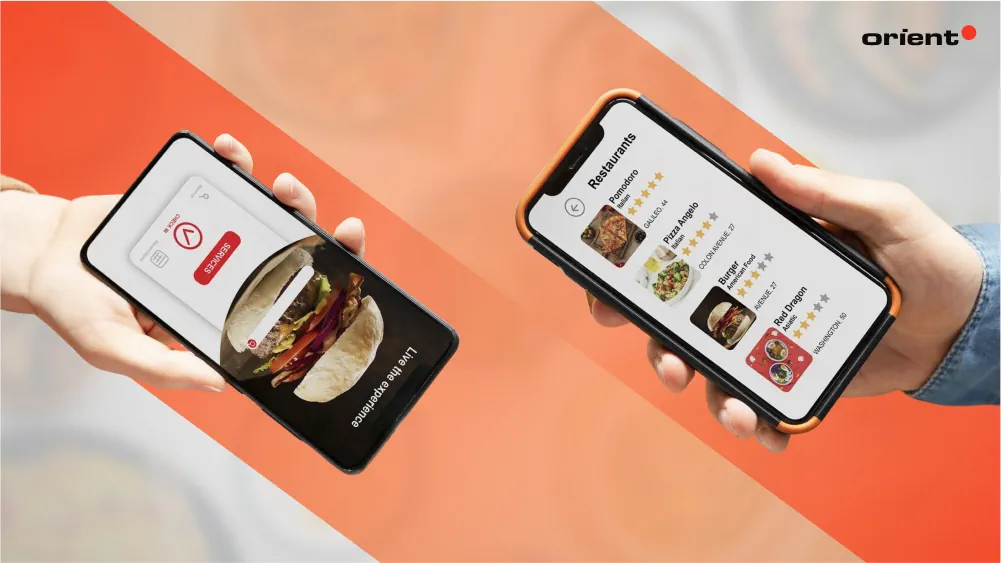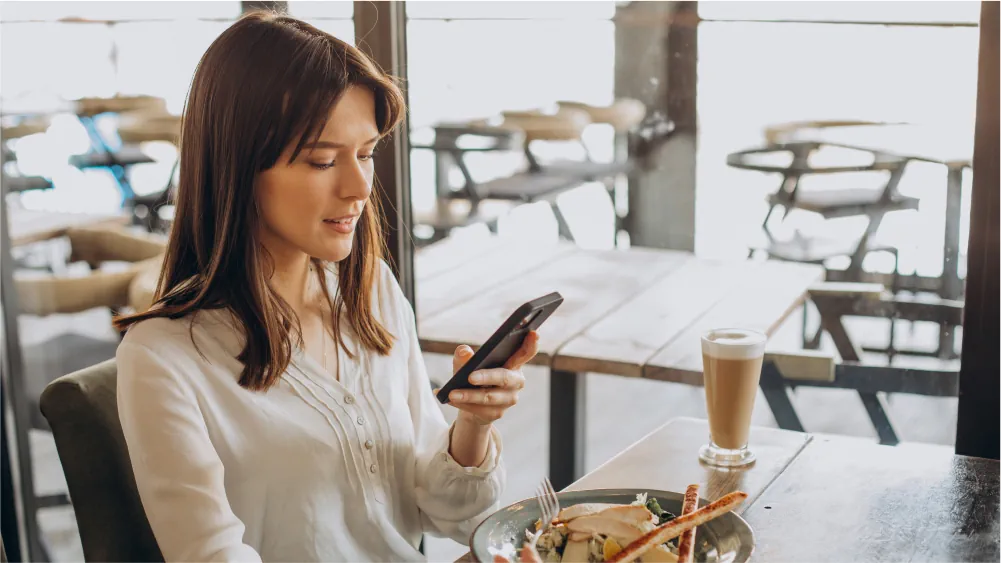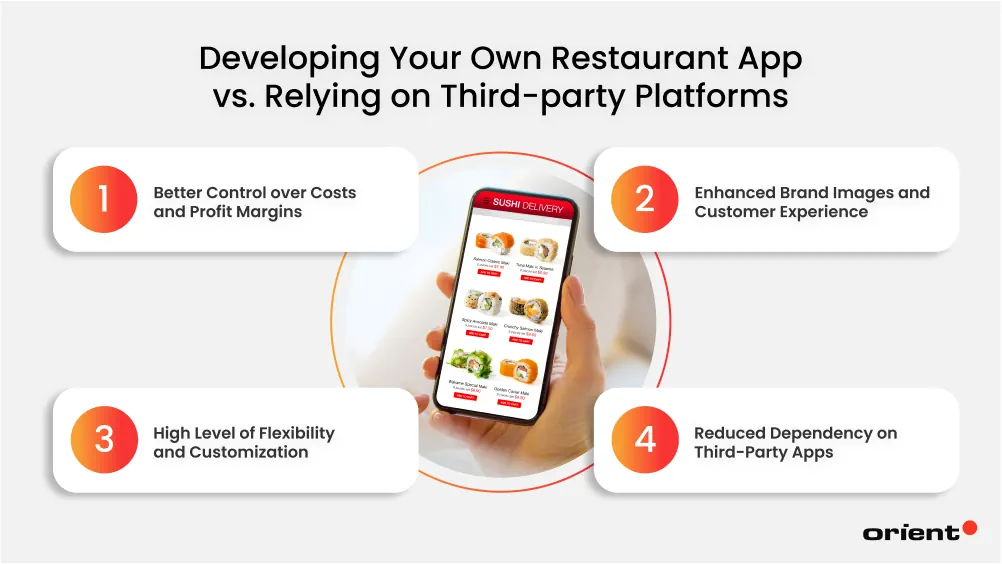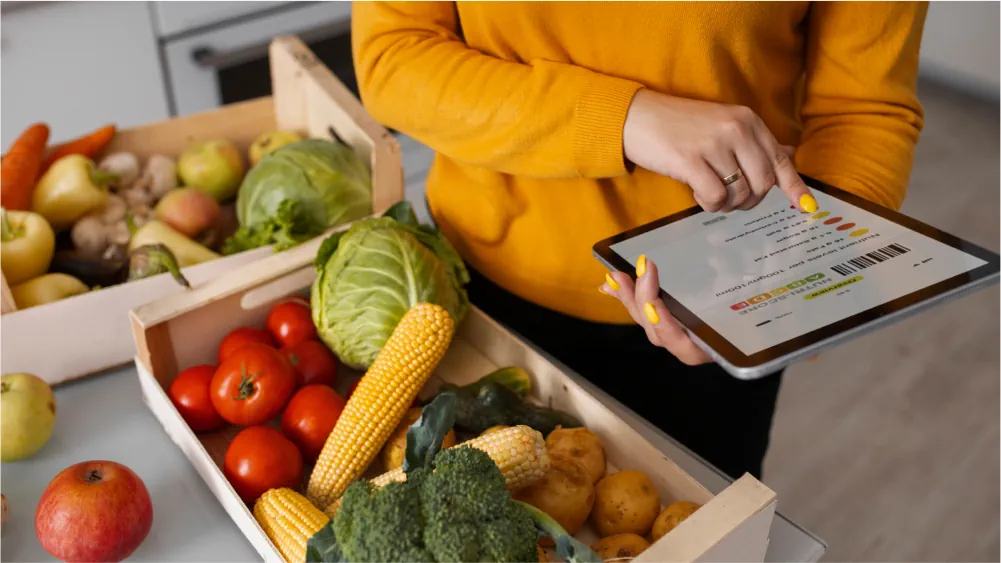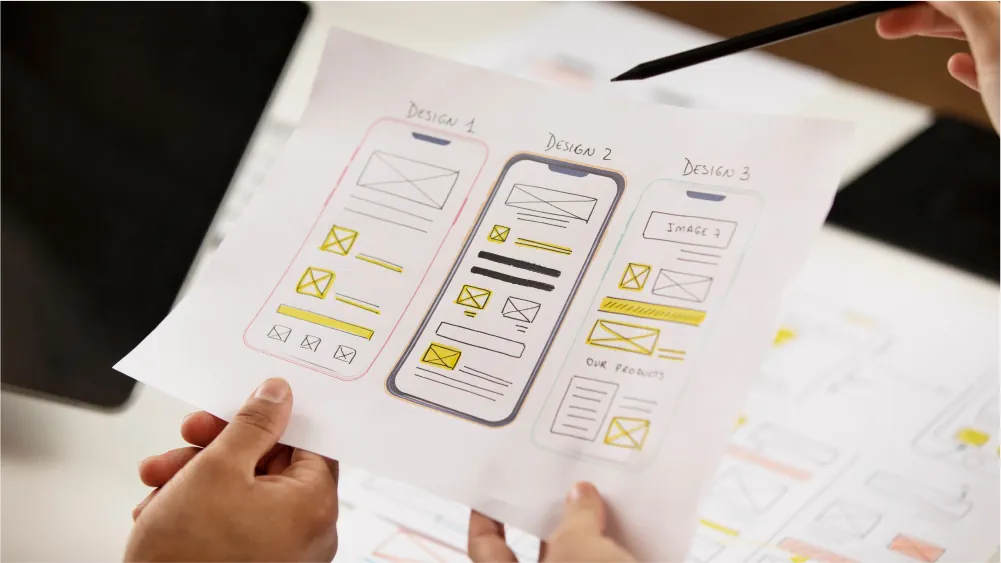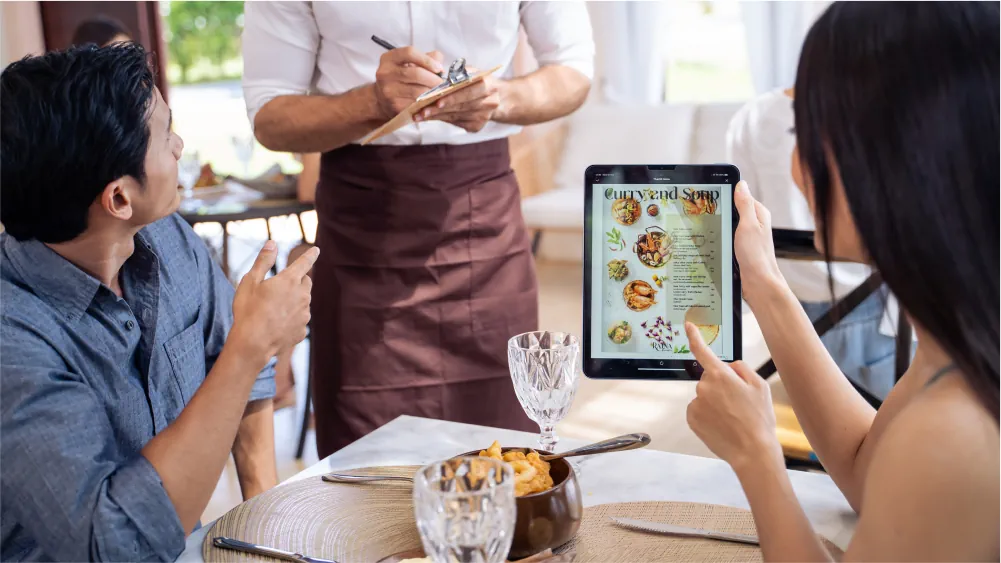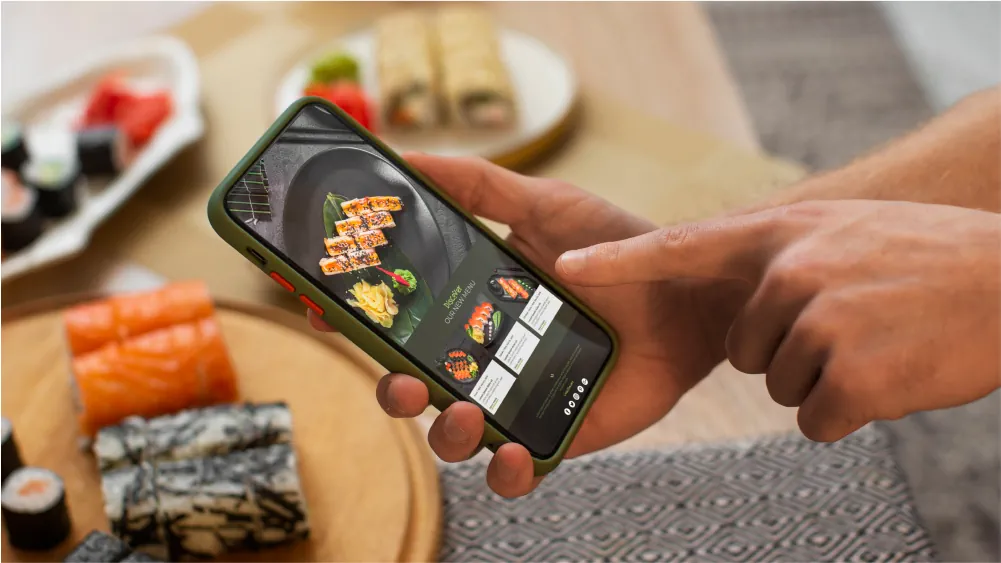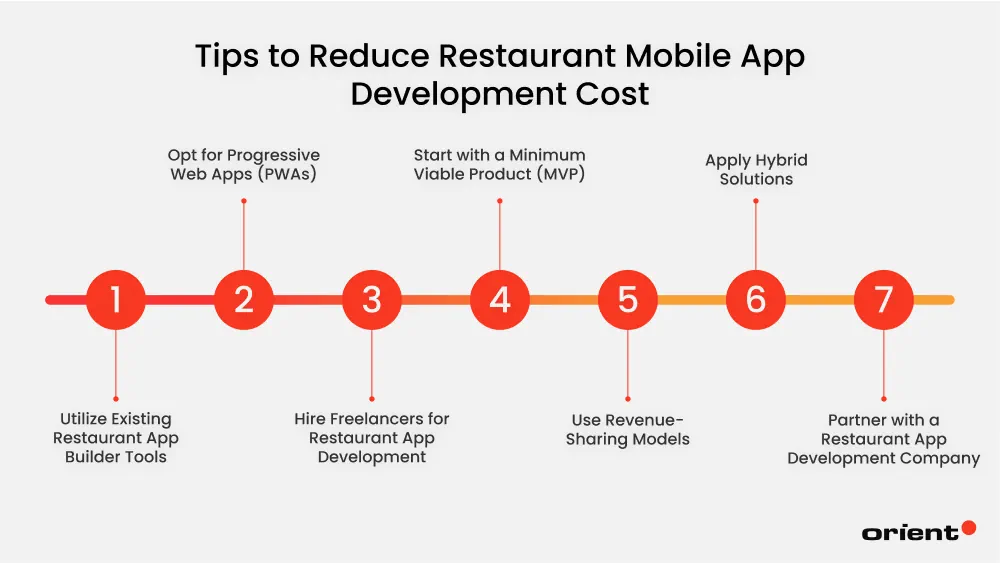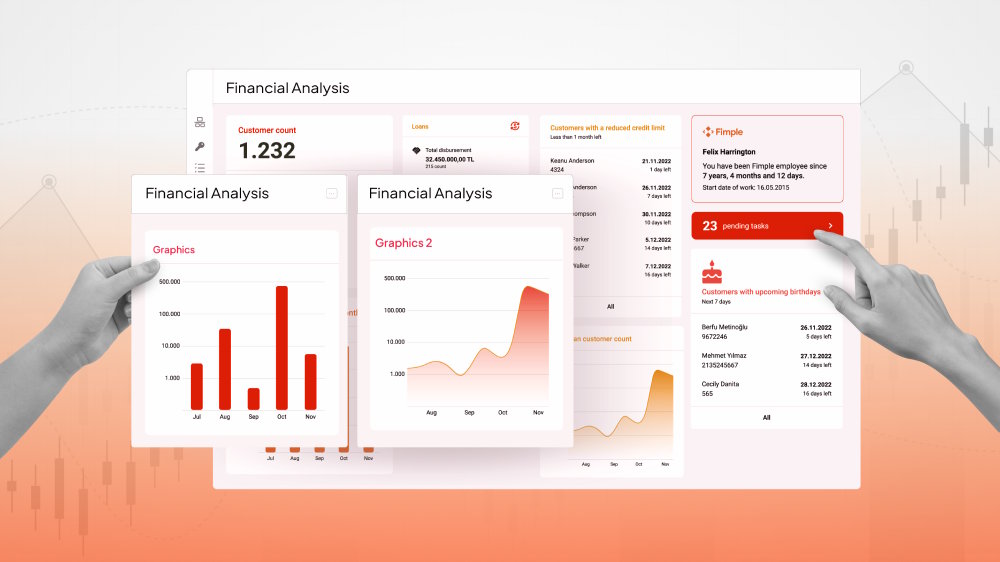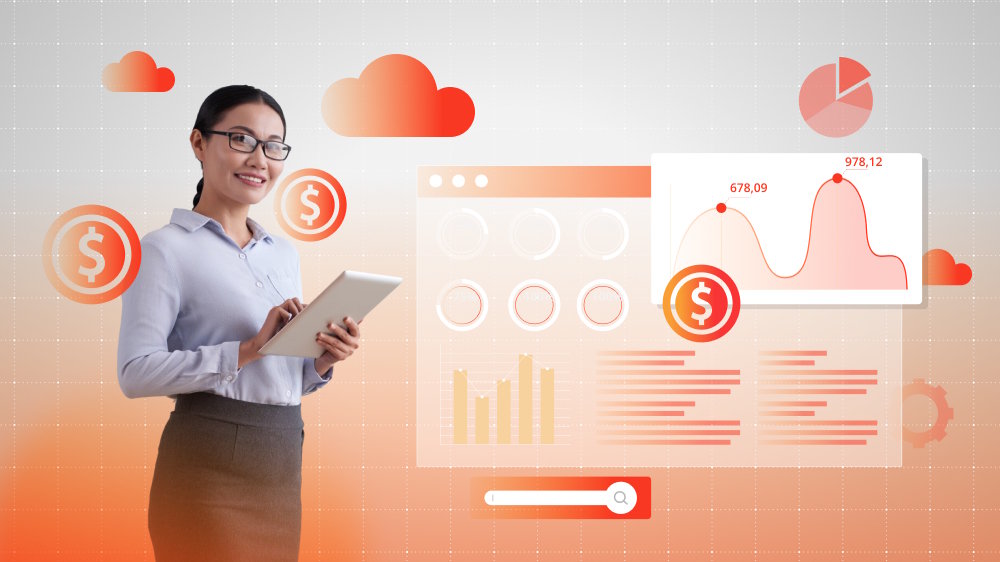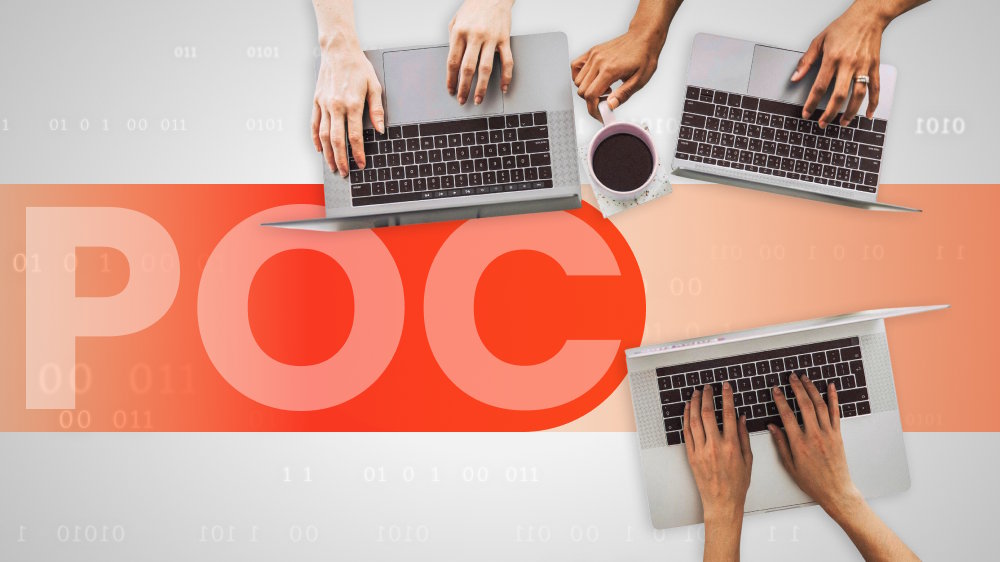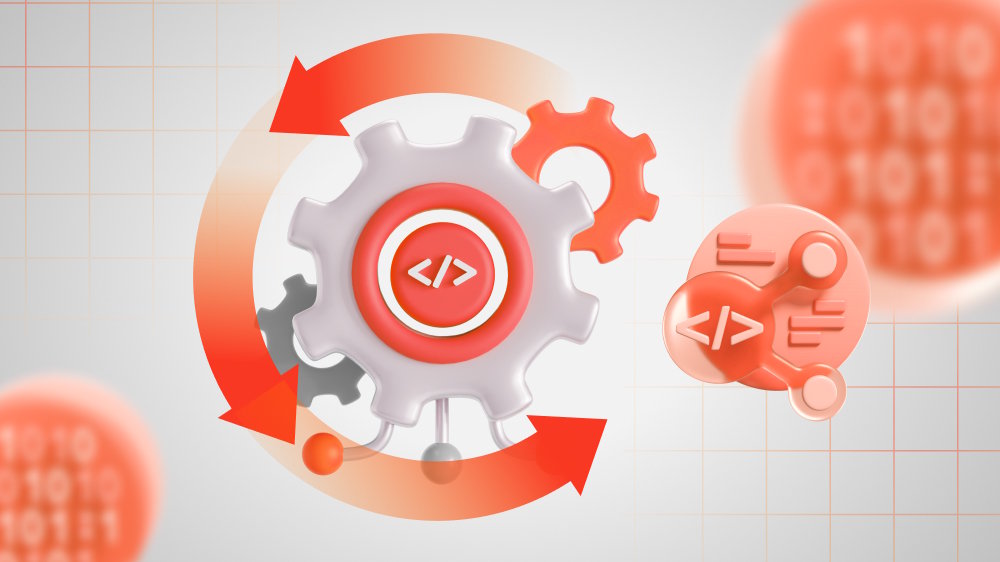Types of delivery apps are on the rise due to the evolving demand for doorstep services. Among grocery delivery apps, which is considered the second most profitable niche, food delivery app development undeniably remains the industry leader.
Some businesses partner with third-party food delivery platforms to seize a great opportunity and bring their menu online. Meanwhile, others decide to create restaurant apps and develop their own ecosystem by self-providing food delivery service in the comfort of customers’ homes or offices.
However, by comparing the pros and cons of the two methods from a business perspective, self-development is still considered a more optimal option. Undeniably, creating restaurant apps is a challenging task, but the final outcomes might amaze you due to the higher value in terms of brand recognition and customer experience optimization. With a minimal budget, how to create a restaurant app but still generate profit is a widespread concern of businesses regardless of size. Read on to find your solutions for restaurant mobile app development.
The Rising Demand for Restaurant Mobile Application Development
![The Rising Demand for Restaurant Mobile Application Development]()
The pervasive influence of digital technology has revolutionized the way people interact with various types of services, including food delivery from restaurants. In the past, customers had only one option for satisfying their hunger: going to a restaurant. Today, the rapid development of restaurant mobile apps provides them with a more convenient and unique dining experience than ever before.
Just a few taps and meals are delivered right to the doorstep. This model is especially suitable for busy customers who only have a little to no time to travel and individuals whose geographical location is not convenient to the restaurant.
According to Statista, the market size of the global online food delivery sector was estimated at over one trillion U.S. dollars in 2023. Although traditional reservations and orders are still the top choices for consumers to fully enjoy the flavor and ambiance of a meal, they no longer remain the only method to succeed in the competitive restaurant industry.
Many, if not most, reputable restaurants today have integrated online ordering services in addition to direct service to stay competitive. Instead of just profiting from customers who visit the restaurant and dine in person, businesses now indirectly receive additional income from online users who want to enjoy the menu at home. As such, restaurant app development has become a strategic imperative for establishments aiming to meet customer demand and thrive in the digital-first era.
Why Developing Your Own Restaurant App Is Better than Relying on Third-party Platforms
Why develop a restaurant app instead of linking with third-party platforms to simplify service listing? Unlike partnering with a third-party platform to list your restaurant business, which incurs associated fees, self-developing your custom restaurant app brings high benefits in terms of brand recognition and customer loyalty. However, that’s not all, as the benefits of self-development go beyond that.
![Why Developing Your Own Restaurant App Is Better than Relying on Third-party Platforms]()
Better Control over Costs and Profit Margins
Instead of relying on the help of third-party platforms to bring your food service closer to online customers, self-sufficient businesses in the restaurant app development process have great advantages in terms of cost and profit control. Using a completely in-house approach, the company has complete control over its financial planning for the software development life cycle, from deployment and maintenance to upgrades according to its specific needs.
Connecting with vendors is undeniably a quick and convenient way to reach app users. However, this often involves fees and commissions charged by the vendors for each completed order. Certain third-party delivery platforms impose fees that can reach up to 30% of each order, significantly impacting a restaurant’s profitability. Prolonged costs incurred negatively affect the project’s profit margin. Instead, an internally developed app gives businesses autonomy over pricing structures, promotions, and loyalty programs to directly influence profit margins and increase ROI software.
Enhanced Brand Images and Customer Experience
If a restaurant owner chooses to link their restaurant services with third-party delivery platforms, a low percentage of them successfully build brand recognition. These platforms often prioritize their own branding over that of individual restaurants. Besides, according to app usage behavior, app users tend to pay more attention to the main application they access instead of the sea of brand options presented on the platforms. As a result, partnering with third-party vendors can potentially hinder companies’ ability to establish their own unique identity.
By using a direct-to-consumer approach through distinct restaurant apps, businesses open a full control opportunity for brand presentation while freely customizing their menu, promotions, and special offers in accordance with their own operating and marketing strategies. All of these elements further solidify the restaurant brand’s reputation and distinguish it from competitors.
High Level of Flexibility and Customization
By collaborating with third-party platforms, restaurant founders can only list their food offerings while all customization options are limited. However, things are different with self-development. Having full control over the operation and future of in-house restaurant apps helps businesses be more flexible in implementing unique features, personalized loyalty programs, and seamless integration with their existing systems. Such customization not only helps to adapt promptly to changing market trends, technological advancements, and customer behaviors but also drives customer satisfaction and loyalty.
Reduced Dependency on Third-Party Apps
Every playground has its own rules. Once you choose to use a third-party platform to serve meals to online customers, you must accept the policies of the platform you use, even though they may drastically affect your restaurant’s offering and brand visibility. Fluctuating commission rates change your entire financial plan, limited access to customer data hinders the analysis of customer consumption behavior, and competition from similar establishments listed on the same platform hinders your visibility, which are some typical examples.
On the contrary, investing in your own restaurant app reduces the level of dependency on third-party platforms. Businesses now gain greater autonomy and the freedom to tailor apps to their own needs.
How to Create a Restaurant App Like DoorDash
As you may know, DoorDash is a prominent player in the food delivery industry. According to official sources, DoorDash is the country’s most popular food delivery service, with more than 65% of the market share, along with its subsidiaries. This brand is considered the ideal model that many businesses aim for when venturing into the restaurant mobile app development process.
There are many ways to get started with the restaurant mobile app development process. Below is a comprehensive guide to help you understand what’s required, whether you’re building it from scratch or hiring a development team.
Phase 1: Market Research & Planning
You can’t start delivering value to your customers if you don’t know what you want and, of course, what your target customers want. Doing this helps you organize everything into a master plan that guides the next stages of your project. This is why market research is always the first step in every development process.
In the beginning, it’s understandable that you might feel overwhelmed and not ready for such an investment. Don’t force yourself to start with something too big. Instead, start small and break the phase into two similar steps below.
![Phase 1: Market Research & Planning]()
Define Business Model
- Choose a single restaurant app (branded delivery app) if you only own one restaurant or food truck and want to build a direct relationship with customers.
- Choose a chain app (multi-branch management) if you have two or more restaurant locations (or plan to expand) and want to centralize operations and customer data.
- Choose an aggregator app (like DoorDash or Uber Eats) if you don’t own a restaurant but want to build a multi-vendor platform, acting as a middleman between restaurants and customers.
The business model answers the question: “What kind of restaurant app are you building, and how will it make money?” By defining your chosen business model right in the early stages, even before the market research, you can easily narrow down your research and invest your focus on a specific aspect rather than allocating resources to any unnecessary niche.
Without defining the business model first:
- Your market research might be too broad or misaligned.
- You wouldn’t know which customers matter most (e.g., diners vs. restaurant owners vs. delivery drivers).
- You could waste time researching the wrong niche.
Research Target Market
Once you have outlined the model, it is time to take a closer look at your potential app users and market competitors.
Anyone can be your potential customer. However, there is only one group of target audience. Are they busy professionals, students, or families? Once you have successfully portrayed your main customer group, dig deeper into their preferences and behaviors and identify their pain points when using similar apps. For competitors, focus mainly on the food ordering app market situation at the time of the research and your direct competitors, such as DoorDash, Grubhub, Uber Eats, Deliveroo, etc.
Although these tasks take up a lot of your time in the initial phases, they play an important role in determining your unique selling proposition (USP) and outlining the development roadmap in the next steps of your restaurant mobile app development project.
Phase 2: App Architecture & Feature Planning
Based on your analysis of the top restaurant apps, you have a rough idea and a general view of the features that are needed in a given restaurant mobile app. It is time to set up your own top must-have features for your software. The choice of which features to include is entirely up to your vision of the project and product, without following any rules.
Typically, planning a restaurant app architecture includes defining three main components:
Define Features for Customer-Facing App (for end users ordering food)
This is the main app that customers use to browse restaurants, order meals, and make payments.
| Category | Description |
|---|
| User Onboarding | Sign up, login (via email, social, or phone OTP) |
| Restaurant Discovery | Browse/search nearby restaurants by category, rating, or cuisine |
| Menu Navigation | View restaurant menus with images, ingredients, price |
| Order Customization | Select dish options (size, toppings, spice level) |
| Add to Cart & Checkout | Seamless ordering with multiple items |
| Real-Time Order Tracking | Live updates on preparation, pickup, and delivery status |
| Payment Gateway | Multiple payment methods (credit, debit, wallet, Apple Pay, etc.) |
| Ratings & Reviews | Leave feedback for dishes or restaurants |
| Push Notifications | Order status, promotions, and offers |
| Profile & Order History | View previous orders, reorder, edit profile |
| Loyalty Program (optional) | Earn points or rewards for frequent use |
Define Features for Restaurant Dashboard (for restaurant owners/managers)
If you choose an aggregator app (like DoorDash, Uber Eats) as your business model, a restaurant dashboard is required to provide restaurant owners with needed tools and features to manage their orders, menus, and operations. However, you can skip this step if the aggregator app is not your direction.
| Feature Category | Description |
|---|
| Login for Restaurant | Secure login for restaurant staff |
| Menu Management | Add/edit dishes, upload images, set prices, mark availability |
| Order Management | Receive new orders, update order status (accepted, cooking, ready) |
| Live Order Notifications | Instant alerts for new or updated orders |
| Delivery Assignment (optional) | Assign orders to drivers or mark for pickup |
| Operational Hours | Set business hours, break times, and closures |
| Analytics Dashboard | View sales data, top-selling dishes, peak hours |
| Promotions | Set special offers or discount codes |
| Customer Interaction | Message or call customer for order clarification (optional) |
Define Features for Delivery Driver App (for couriers/delivery staff)
This is for drivers who receive delivery tasks, navigate to restaurants/customers, and confirm drop-offs.
| Feature Category | Description |
|---|
| Driver Sign In | Secure login and profile management |
| Available Tasks | View pending deliveries in their zone |
| Accept/Reject Orders | Flexibility to take available jobs |
| GPS Navigation | Real-time routing to restaurant and customer location (via Google Maps or Mapbox) |
| Order Pickup & Drop Confirmation | Tap to mark pickup or delivery complete |
| Delivery Status Updates | Updates sent to customer in real time |
| Earnings Dashboard | Track earnings by day/week/month |
| Ratings & Reviews | View or respond to customer feedback |
| Availability Toggle | Go online/offline based on shift or capacity |
Define Features for Admin Panel (for the platform owner)
This is usually a web-based dashboard, accessible only by you (the platform owner) and authorized admins to manage the entire restaurant mobile app.
| Feature Category | Description |
|---|
| User Management | View, edit, activate, deactivate or ban customers, restaurants, and drivers. |
| Restaurant Management | Approve/reject new restaurant signups, manage profiles, set commission rates. |
| Driver Management | Onboard drivers, assign delivery zones, monitor performance, suspend accounts. |
| Order Monitoring | Track live and historical orders, reassign deliveries, manage fulfillment flow. |
| Payments & Earnings | View all transactions, set platform fees, track restaurant/driver payouts. |
| Promotions & Discounts | Create and manage promo codes, campaigns, and free delivery rules. |
| Analytics & Reporting | Dashboard with metrics on orders, revenue, top restaurants, busy hours. |
| Content Management (CMS) | Edit FAQs, push notification content, promotional banners. |
| Notifications | Send manual or scheduled push notifications, SMS, or emails to user groups. |
| Role-Based Access Control | Assign roles (admin, support, finance), manage their feature access. |
| Platform Settings | Configure currency, time zones, app name, terms & policies, tax settings. |
| Support Tools | Access logs, ticket history, user inquiries, and manual overrides. |
Phase 3: Designing UX/UI
While UX design refers to how the app works, UI design is how the app looks. This stage aims to transform your app’s functional ideas from the previous steps into a visual and interactive experience. In addition to following the company’s brand guidelines, the app interface needs to be intuitive and easy to use to achieve better customer engagement.
So, what do you need to do at this stage of restaurant application development?
![Phase 3: Designing UX/UI]()
Structure the App Experience (UX Design)
A confused user will leave your app. Instead, an intuitive flow keeps conversion high. Imagine you are a customer seeking online food ordering. How will you move through the restaurant app? Using this logic, along with the data you collect from potential users, map out the customer journey, starting with creating wireframes to define layout and navigation. Tools like Figma, Sketch, or Adobe XD may help in this situation. Note that for key actions like placing an order, minimizing the steps to complete such a task is required to achieve more completed orders and profit efficiency.
Design the Visual Interface (UI Design)
Once the wireframes are ready, the next step is to bring the app’s look and feel to life through high-fidelity mockups. This process typically involves key tasks including adding your brand colors, typography, button styles, imagery, and other visual elements that define the app’s identity. Due to the fact that most users today use smartphones to access the online food ordering system, the design should be mobile-first and include optional enhancements like dark mode for visual comfort.
Ensure Accessibility and Responsiveness
Since you can’t predict exactly what devices your users will use to access your restaurant app, making the app usable and visually consistent across all screen sizes and devices is essential to ensuring a seamless customer experience. To achieve this, accessibility features should be embedded, and gestures like swiping and long-pressing should be tested.
Phase 4: Choosing a Technology Stack
Making your restaurant app work as expected requires the support of the right technology stack. Choosing a technology stack focuses on selecting the right tools, frameworks, and platforms that will power your restaurant app behind the scenes. Based on the chosen type of mobile app development (native app development for both Android and iOS or hybrid one for separate operating systems), the required tech stack for restaurant software is different from case by case. If your food ordering app is a web app, the tech stack used is obviously different as well.
For instance, the utilization of Kotlin or Java is required for Android app development, Swift or Objective-C for iOS app development, and Flutter for the creation of hybrid applications.
Here are some suggested tech stacks for each development process:
![Phase 4: Choosing a Technology Stack]()
Tech Stack for Frontend Development
Anything that is visible to restaurant app developers and the users and can be interacted with (e.g., clicks, taps, or scrolls) falls under the frontend category. To choose the right tech stack for your app’s frontend, you need to clearly define your project’s technical needs and requirements.
- For mobile apps with cross-platform experiences: use Flutter or React Native
- For mobile apps with native looks and feels: use Swift for iOS and Kotlin for Android
- For web admin panel: use modern JavaScript frameworks like React.js, Angular, and Vue.js
Tech Stack for Backend Development
The backend handles all the logic, data storage, authentication, and communication between users and the server. As backend development involves many different tasks to keep the restaurant app running smoothly, it is recommended to list out all the needed components, then find and choose the tech stack corresponding to each.
- For server: use Node.js, Python (Django/Flask), or Ruby on Rails
- For database: use relational databases like PostgreSQL, MySQL, or flexible NoSQL options like MongoDB
- For real-time updates: use tools like Socket.io or Firebase Realtime Database
Tech Stack for Infrastructure
Infrastructure is where your restaurant app lives, how it runs, and how updates are delivered. It includes the servers, hosting platform, and tools used to keep your platform online 24/7, handle thousands of users at once, and let you publish updates quickly without breaking live service. Typically, dedicated mobile app developers use the following tech stacks for the components below:
- For cloud services: use AWS, Azure, Google Cloud Platform
- For CI/CD (Continuous Integration/Continuous Deployment): use GitHub Actions, GitLab CI, or Bitbucket Pipelines
- For containerization (optional): use tools like Docker
Third-Party APIs Integration
Essential features on a restaurant application, such as maps, payments, SMS, notifications, and tracking, if developed from scratch, are very expensive and time-consuming. That is why most food delivery apps today heavily integrate with third-party APIs to save resources while improving user experience. Below are some third-party solutions that you can refer to:
- For maps: use Google Maps API, Mapbox
- For payments: use Stripe, PayPal, Razorpay
- For messaging/OTP: Twilio, Nexmo, Firebase Auth
- For push notifications: use Firebase Cloud Messaging (FCM), OneSignal
- For analytics: use Google Analytics, Mixpanel, Firebase
- For delivery management: use Onfleet, Tookan, Shipday
Phase 5: Restaurant App Development
Everything is in place. Now, all you need to do is start your development journey. Are you ready to turn your idea into a real restaurant app? No matter how impatient you are, don’t forget the steps below.
![Phase 5: Restaurant App Development]()
Testing before Launch
No project owner wants a restaurant app to fail frequently. Testing is an indispensable step that acts as a way to double and triple check your restaurant mobile app before going live. By simulating real food ordering scenarios in many different test cases, testing gives you a more objective view of the product, even when it is not yet officially operational.
Many people think that testing is just a process that involves software developers, but it is not. Besides implementing types of testing techniques such as unit testing (for developers), integration testing (for full flows), performance testing, etc., it is advisable to organize user acceptance testing to get feedback from non-developers. Their opinions will give you many interesting insights about the product from the perspective of real users that you may sometimes miss when focusing too much on technical problems only.
Testing is definitely not an easy-to-go process. Here, we provide you with some special notes related to testing specifically for your custom restaurant app development:
- Don’t just click the button; simulate a full online transaction instead.
- Test menu logic carefully, as it is more complex than how it seems (e.g., varying items, time-sensitive dishes, sold-out logic).
- Test order status updates across all roles (e.g., drivers, customers, admins) to ensure real-time capability.
- Simulate edge cases in payments and prepare the solutions for each.
- Test under weak or intermittent Internet, especially for order submission, map tracking, and status updates.
- Do multi-user testing sessions that involve a customer, a restaurant owner, or a delivery driver to detect bugs during simultaneous actions.
Deployment & Publishing on App Stores
As testing has kept everything on track as you expected, the moment you’ve been waiting for - launching the restaurant mobile app on Google Play Store and Apple App Store - has arrived. To successfully submit your restaurant app on app stores, make sure that the images you submit to the platform are real screenshots of your own restaurant app. Also, consider using keywords related to your service and cuisine, as well as adding regional cuisine tags to increase visibility in search results and reach the right audience in the right country or city.
The app approval process, which typically takes somewhere between 1-3 working days for Android (Google Play) and 2-5 business days for iOS (Apple App Store), can take even longer than expected, causing delays of 3-7 days or more if:
- Push notification permissions aren’t properly explained.
- Location access isn’t clearly justified.
- In-app purchases or third-party payments raise flags.
So, what exactly are the app publishing rules on the Google Play Store and Apple App Store? Check out the table below.
| Category | Google Play Store | Apple App Store |
|---|
| Privacy | Must provide privacy policy & data form | Must explain data use & fill out App Privacy Details |
| Permissions | Sensitive permissions must be justified | Must show reason (purpose strings) for each permission requested |
| Payments | - For real food: can use any method including Stripe, PayPal, Momo, ZaloPay, etc.
- For digital features (VIP, virtual items): must use Google in-app purchases (with fees) | - For real food: can use any method including Stripe, PayPal, Momo, ZaloPay, etc.
- For digital features (VIP, virtual items): must use Apple in-app purchases (with fees) |
| Login | No restrictions | Must support Sign in with Apple if others used |
| App Content | Must follow Google Play Developer policies | Must provide real value |
| App Store Optimization | - App name and keywords must match content
- Screenshots and description required | Description, screenshots, keywords must reflect actual app use |
How Much Does It Cost to Develop an App for a Restaurant?
As a type of software development, food ordering apps don’t have any fixed prices. To accurately estimate restaurant mobile app development costs, you need to take a closer look at your own project requirements. Does the app have many advanced features? Is your restaurant app iOS only or both iOS and Android? What are your development team types (freelancers, software development company, in-house)? Is the development timeline of the project urgent?
However, if you are still looking for a price list to refer to, the table below can give you some interesting insights. Note that actual costs may vary more or less depending on your technical needs.
| App Type | Estimated Cost (USD) |
|---|
| Single Restaurant (basic features) | $10,000 - $25,000 |
| Single Restaurant (with delivery, loyalty) | $25,000 - $50,000 |
| Multi-branch Chain App | $40,000 - $80,000 |
| DoorDash-style Aggregator App | $80,000 - $250,000+ |
Tips to Reduce Restaurant Mobile App Development Cost
While the budget to make this a success is incredible, it doesn’t mean you can’t create your own restaurant app with minimal investment. Using a restaurant app maker is a popular way to build quality products. However, there’s more to what you can do to minimize development costs than that.
![Tips to Reduce Restaurant Mobile App Development Cost]()
Utilize Existing Restaurant App Builder Tools
Before moving on to other methods to help you reduce investment costs, let’s begin with the most popular one - leveraging existing restaurant app makers. These are tools designed specifically to simplify the process of developing restaurant apps for users regardless of expertise. With a user-friendly interface, countless pre-built templates, and customized features, these platforms allow beginners without extensive coding knowledge to freely tailor their restaurant apps to their needs.
Compared to the entirely self-development approach, which consumes budget, time, and effort, no-code or low-code app builders are a more affordable solution as they handle almost all infrastructure, updates, and maintenance. Subscription-based models supported by types of builder tools help restaurants to start small and expand their app’s capabilities as their business grows.
Opt for Progressive Web Apps (PWAs)
A restaurant app does not necessarily require a complex mobile platform when it can be accessed through web browsers and provide app-like functionality, even without being downloaded from app stores like Apple App Store or Google Play Store. This strategic approach is called Progressive Web Apps (PWAs) - a cost-effective alternative to traditional native app development.
By allowing restaurants to leverage web technologies to deliver features such as offline access and push notifications, PWAs help you reduce the application development costs that come with running multiple operating systems in parallel. Just develop once, and you will get all you need, simplifying future maintenance and updates and optimizing a seamless user experience.
Hire Freelancers for Restaurant App Development
The success of your restaurant app is built on the foundation of a skilled team. Of course, you can still take advantage of in-house developers to complete the project. However, this option is only suitable for businesses with abundant human resources as costly and time-consuming hiring processes may hinder the efficiency and cost-effectiveness of building a restaurant app, especially for those seeking to minimize investment.
Meanwhile, exploring alternative development approaches, such as hiring freelancers, gives businesses an opportunity to access specialized skills, reduce fixed costs, and expedite the development process. You can use freelancing methods depending on your needs and project length without long-term commitment while still ensuring the successful creation of a high-quality restaurant app.
Start with Minimum Viable Product (MVP)
To predict user reactions to your restaurant app, you can start small with a Minimum Viable Product (MVP) instead of immediately implementing the entire development process. By focusing on developing a test application that includes only core features and functionality, businesses efficiently allocate resources while mitigating excessive costs. With feedback collected from early adopters, companies have a clearer view of user satisfaction ratings for new products based on real-world usage and preferences, thus eliminating or refining redundant and unnecessary features for later major versions.
Use Revenue-Sharing Models
The revenue-sharing model is an approach that entails establishing partnerships with restaurants or other relevant entities, including both the revenue generated and development costs for the apps distributed among the involved parties. Simply put, this model reduces initial development costs in exchange for a percentage of the app’s future earnings. The incentive split can be equal or proportional, depending on the agreement between the two parties.
The revenue-sharing model is especially suitable for startups with limited investment capital who still need to develop software products. As the budget used for the necessary resources and expertise during the development process is shared throughout the collaborative environment, businesses reduce the financial burden and speed up the process of launching a restaurant app to the market. However, it is worth noting that this model is a highly risky method requiring extensive knowledge of participants.
Apply Hybrid Solutions
Besides the PWA approach, applying hybrid app development that combines elements of both web and native applications is also an effective method to create a restaurant app with minimal investment. By using frameworks like Flutter or React Native, hybrid solutions allow the development team to write a single codebase and deploy it on various platforms, reducing the time and capital costs spent on building separate native apps for iOS and Android. If you need to add a new feature or perform maintenance, do it once, and all changes will be automatically updated on all platforms.
Partner with a Restaurant App Development Company
Partnering with a software development company to shorten time to market and increase development efficiency is no longer a new approach for businesses, especially those organizations that want to achieve fast launch. Outsourcing services allow you to fill all staffing gaps in a single package, saving on overhead and onboarding time without the need for recruitment sessions. If you choose countries in Southeast Asia like Vietnam as your destination for restaurant mobile app development, you can reduce costs by 50-70% owing to their competitive hourly rates, all while maintaining quality.
Restaurant App Development Services for Your Success
Creating a restaurant is undeniably a daunting task. Although tips for minimal investment are already being applied, it is worth noting that additional costs can still arise due to future uncertainty. Risk management plays an important role in such situations. If you are looking for expert advice for improved operational strategies or have the need to hire restaurant app developers for your unique restaurant app development project, feel free to contact Orient Software for devoted help.


